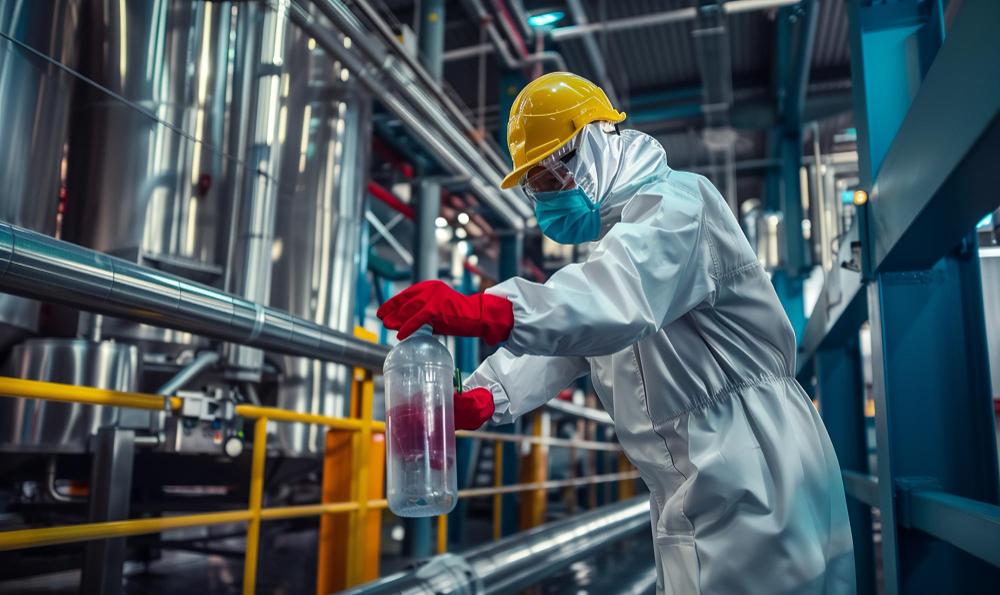What is a Degreasing Agent?
A degreasing agent is a specialized cleaning solution designed to remove grease, oil, and other contaminants from various surfaces. These agents are crucial in industrial maintenance to ensure machinery and equipment stay clean and functional. By breaking down the molecular structure of grease, degreasers make it easier to clean and maintain surfaces without leaving any residue.
Degreasing agents come in various formulations, each designed for specific cleaning needs. These formulations can be water-based or solvent-based. Water-based degreasers are often preferred for their environmental benefits as they are typically non-toxic and biodegradable. Solvent-based degreasers, on the other hand, are more powerful and used for heavy-duty cleaning tasks.

Uses and Benefits
Uses:
-
- Machinery maintenance: Degreasers are essential for cleaning and maintaining industrial machinery, ensuring they operate efficiently.
- Surface preparation: Before painting or coating, surfaces must be free of grease and oil, making degreasers crucial in these processes.
- Automotive cleaning: Used in garages and workshops to clean engine parts and other components.
- Food industry: Essential for cleaning kitchen equipment and surfaces, ensuring hygiene and safety.
- Manufacturing: Used to clean tools and equipment to maintain production efficiency.
- Marine industry: Cleans boat engines and other parts exposed to harsh marine environments.
Benefits:
-
- Effectively removes grease and oil: Degreasers are designed to tackle tough grease and oil, ensuring surfaces are thoroughly cleaned.
- Prepares surfaces for painting and coating: Clean surfaces are crucial for the adhesion of paints and coatings.
- Increases machinery lifespan: Regular cleaning with degreasers prevents the buildup of grease, reducing wear and tear on machinery.
- Reduces maintenance costs: Clean machinery operates more efficiently and requires less frequent repairs.
- Improves safety: Reducing grease on surfaces minimizes the risk of slips and falls, enhancing workplace safety.
- Eco-friendly options available: Many modern degreasers are formulated to be environmentally safe, reducing their impact on the planet.
- Versatile use: Applicable in various industries from automotive to food processing.
- Enhances productivity: Clean machinery and tools lead to smoother and faster operations.
- Protects surfaces: Prevents corrosion and damage caused by accumulated grease and oil.
- Easy to use: Most degreasers are straightforward to apply and require minimal effort to achieve effective cleaning.
What Makes a Cleaning Agent Safe?
A safe cleaning agent minimizes harm to both users and the environment. Here are key factors that contribute to the safety of a cleaning agent:
-
- Non-toxic ingredients: Safe cleaning agents are free from harmful chemicals that can cause health issues. They do not contain substances that can be inhaled or absorbed through the skin, ensuring user safety during application.
- Biodegradable: They break down naturally, reducing environmental impact. Biodegradable agents decompose through natural processes, preventing long-term pollution.
- Free from harsh solvents: Avoids using solvents that can be harmful to human health and the environment. Harsh solvents can cause respiratory problems, skin irritation, and environmental damage.
- pH balanced: Ensures the cleaning agent is not too acidic or alkaline, preventing damage to surfaces and skin. pH-balanced solutions are safer for a wide range of materials.
- No phosphates: Phosphates can lead to water pollution, so safe cleaning agents avoid using them. Phosphate-free agents help protect aquatic life and maintain water quality.
- Low volatile organic compounds (VOCs): Reduces the release of harmful vapors into the air. Low VOC formulations are better for indoor air quality and reduce the risk of inhalation hazards.
- Hypoallergenic: Suitable for individuals with allergies or sensitivities. Hypoallergenic cleaning agents minimize the risk of allergic reactions and skin irritation.
- Safe disposal: Can be disposed of without special handling or treatment. Environmentally safe agents do not require complex disposal methods, making them easier to manage.
How to Select the Right Degreaser
Choosing the right degreaser involves several considerations to ensure it meets your cleaning needs effectively. Here are steps to guide you:
-
- Identify the type of grease: Determine whether you are dealing with light, medium, or heavy grease, as this will influence the strength of the degreaser needed. Different types of grease require specific formulations for effective cleaning.
- Consider surface compatibility: Ensure the degreaser is safe for the material you are cleaning, whether it’s metal, plastic, or another surface. Some degreasers may be too harsh for certain materials, leading to damage.
- Check environmental impact: Opt for biodegradable and eco-friendly degreasers to minimize environmental harm. Environmentally friendly degreasers reduce pollution and are safer for disposal.
- Evaluate cleaning power: The degreaser should be strong enough to clean effectively but gentle enough to avoid damaging surfaces. Balancing cleaning power with safety ensures optimal results.
- User safety: Choose non-toxic, safe-to-handle products to protect users from health risks. Products that are safe to handle reduce the risk of accidents and health issues.
- Application method: Consider whether you need a spray, liquid, or gel form of the degreaser based on the application process. The application method can affect ease of use and coverage.
- Cost-effectiveness: Assess the cost per use to ensure the degreaser offers good value. Cost-effective options provide effective cleaning without overspending.
Cleaning Process of Degreaser
Using a degreasing agent involves a systematic approach to ensure effective cleaning. Here is a step-by-step guide:
Preparation:
-
- Ensure the area is well-ventilated. Proper ventilation helps disperse any fumes.
- Gather necessary protective gear, such as gloves and goggles. Personal protective equipment protects against exposure.
- Read the manufacturer’s instructions for specific guidance. Following instructions ensures correct usage and safety.
Application:
-
- Apply the degreaser directly to the greasy surface. Even application ensures thorough cleaning.
- For spray degreasers, ensure even coverage. Sprays provide a uniform application across surfaces.
Dwell time:
-
- Allow the degreaser to sit for a few minutes to break down the grease. Dwell time enhances cleaning effectiveness.
- The dwell time may vary depending on the product and the level of grease. Follow product instructions for optimal results.
Agitation:
-
- Use a brush or cloth to scrub the surface if needed. Agitation helps lift and remove stubborn grease.
- This helps to loosen and lift the grease more effectively. Scrubbing enhances the cleaning process.
Rinse:
-
- Thoroughly rinse the surface with water to remove the degreaser and loosened grease. Rinsing prevents residue buildup.
- Ensure no residue is left behind, as it can attract more dirt. Complete rinsing ensures a clean surface.
Drying:
-
- Allow the surface to dry completely before using it or applying any coatings. Proper drying prevents moisture-related issues.
- Use a clean cloth or air drying for optimal results. Drying ensures the surface is ready for use or further treatment.
Conclusion
In conclusion, environmentally safe degreasing agents are essential for maintaining cleanliness and efficiency in industrial settings. They offer numerous benefits, including effective grease removal, preparation of surfaces for further treatment, and enhancement of machinery lifespan. Choosing the right degreaser involves considering factors such as the type of grease, surface compatibility, environmental impact, and user safety. By following a systematic cleaning process, you can ensure optimal results and maintain a safe, productive work environment.






